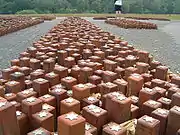
The Holocaust in the Netherlands was organized by Nazi Germany in occupied Netherlands as part of the Holocaust across Europe during the Second World War. In 1939, there were some 140,000 Jews living in the Netherlands, among them some 24,000 to 25,000 German-Jewish refugees who had fled from Germany in the 1930s (other sources claim that some 34,000 Jewish refugees entered the Netherlands between 1933 and 1940, mostly from Germany and Austria).[1][2]: 69 Some 75% of the Dutch-Jewish population was murdered in the Holocaust. The 1947 census reported 14,346 Jews, or 10% of the pre-war population. This further decrease is attributed to massive emigration of Jews to the then British Mandate of Palestine (present-day Israel).
Overview
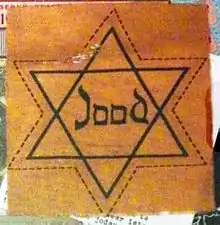
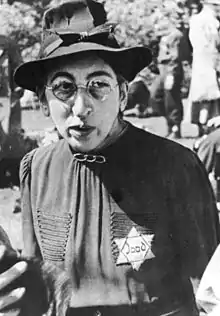
In 1945, only about 35,000 Jews of the Netherlands were alive. The exact number of "full Jews" who survived the Holocaust is estimated to be 34,379 (of whom 8,500 were part of mixed marriages, and thus spared deportation and possible murder in the Nazi concentration camps). The number of "half Jews" who survived in the Netherlands at the end of the Second World War in 1945 is estimated to have been 14,545; the number of "quarter Jews" was 5,990.[3] Some 75% of the Dutch-Jewish population was killed in the Holocaust, an unusually high percentage compared to other occupied countries in western Europe.[4][5][6]
Factors of the larger death toll included the relatively intact governmental apparatus after the royal family and government fled to London. The Netherlands was not under a military regime. It was the most densely inhabited country of Western Europe, making it difficult for the relatively large number of Jews to go into hiding. Most Jews in Amsterdam were poor, which limited their options for fleeing or hiding. The country did not have much open space or forest for people to flee to. Also, the civil administration had detailed records of the numbers of Jews, and their addresses. The average citizen of the Netherlands was unaware of the operation of "death camps" for most of the occupation. All Dutch citizens were required to "register" for work in Germany.[7] When Dutch society recognised German persecution of the Jews, they conducted the first act of mass civil disobedience in Nazi-occupied Europe: the Februaristaking ("February strike"), to show their support for Jewish citizens.
One theory is that the Germans made use of the administrative organizations and Dutch police:
"In their preparations for the extermination of the Jews living in the Netherlands, the Germans could count on the assistance of the greater part of the Dutch administrative infrastructure. The occupiers had to employ only a relatively limited number of their own personnel; Dutch policemen rounded up the families to be sent to their deaths in Eastern Europe. Trains of the Dutch railways staffed by Dutch employees transported the Jews to camps in the Netherlands which were transit points to Auschwitz, Sobibor, and other death camps." With respect to Dutch collaboration, Eichmann is quoted as saying "The transports run so smoothly that it is a pleasure to see."[8]
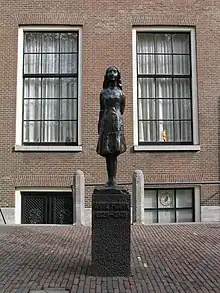
One of the best known Holocaust victims in the Netherlands is Anne Frank. Along with her sister, Margot Frank, she died from typhus in March 1945 in the concentration camp of Bergen-Belsen. Disease was widespread in the camps because of unsanitary living conditions deliberately created by the German occupiers. Anne Frank's mother, Edith Frank-Holländer, was murdered by starvation in Auschwitz. Her father, Otto Frank, survived the war. Other noted Dutch victims of the Holocaust include Etty Hillesum, whose writings were later published;[9] Abraham Icek Tuschinski, and Edith Stein, who converted to Christianity and is also known as Saint Teresa Benedicta of the Cross.
Maurice Frankenhuis built a collection of documents, authored diaries and collected artifacts spanning five decades, from World War I through World War II including hiding, and incarceration in Westerbork and Theresienstadt. His research revealed that he, together with his wife and two daughters may have been the only native Dutch family to survive as a unit.[10]
In contrast to many other countries where all aspects of Jewish communities and culture were eradicated during the Shoah, a remarkably large proportion of rabbinic records survived in Amsterdam, making the history of Dutch Jewry unusually well documented.
Implementation of the Final Solution
Occupation
The May 1940 invasion ended the neutrality of the Netherlands in World War II. Over the following two years, the German occupiers worked with the existing Dutch bureaucracy to gain control of the administrative system. Rather than leaving the Dutch government independent or setting up a military occupation, the Nazis' plan for the Netherlands involved implementing a civil occupation.[2]: 70 Leaders appointed by the Germans to head the civil administration of the Netherlands were all Nazis with a strong ideological history. Hitler's representative, the Austrian Nazi Arthur Seyss-Inquart, quickly took command of the Dutch administrative system as the Reichskommissar for the occupied Dutch territories.[2]: 70 Hanns Albin Rauter was appointed the Higher SS and Police Chief (HSSPF). Rauter reported directly to Heinrich Himmler.[11]: 57 One of Rauter's first initiatives involved consolidating the Dutch police under the Nazi-controlled Ministry of Justice. Rauter positioned the SS and the police to have full authority over the entire Jewish population of the occupied Netherlands.[11]: 21 This gave the SS and the police the ability to persecute Jews in the Netherlands, and eventually implement the Final Solution.[2]: 71 Rauter had not only the Dutch police, but 4,700 German police personnel at his disposal.[11]: 66 After Germany took control of the Dutch government, 128 cases of suicide by Jews were reported.[12]: 300
Registration
In November 1941, the Germans forced all Jewish officials and public servants to register with the Dutch authorities. Subsequently, over 2,500 Jews lost their public positions.[12]: 302 Only the forced removal of Dutch Jews from secondary and higher education incited a response from the public.[12]: 303 On 10 January 1941, Seyss-Inquart mandated the registration of Jewish citizens.[13]: 610 This decree included Jewish citizens with one Jewish grandparent. Citizens identified as Jewish had their identification cards marked with a black J.[13]: 610 Carried always, these identification cards were a useful tool for the perpetrator to distinguish who was Jewish. Furthermore, these identification cards were nearly impossible to forge. The birth, death, and marriage records of Jews in the Netherlands were marked to differentiate them from the non-Jewish citizenry.[12]: 304 By 1942, Jews were forced to wear a yellow star on their clothing.[13]: 615
The geography of the Netherlands made it impossible for Jews to flee. The country of Holland is less than 20,000 square miles of flatlands.[2]: 71 During the civil occupation, it is estimated that 25,000 Jews in the Netherlands went into hiding. Of these 25,000, a third were caught and deported. Of those who survived, 4,000 were little children.[2]: 72 Some were betrayed by friends, or strangers who agreed to hide them under false pretenses. Others were caught by the police.[2]: 72
Robbery
Before being deported and murdered, Dutch Jews were systematically robbed of all of their possessions, including businesses, real estate, financial assets, artworks and household possessions.[14] Gerard Aalders, a Dutch researcher at the Netherlands State Institute for War Documentation, estimated that the Dutch Jewish community was "the most affected by German rapacity".[15] Looting organisations included the Dienststelle Mühlmann, headed by Kajetan Mühlmann under Seyss-Inquart, and the LiRo bank, a Jewish bank called Lippmann & Rosenthal & Co. that had been taken over by Nazis to disguise theft as legal transactions, among others.[16]
Deportations
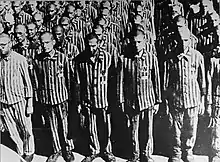

When Seyss-Inquart and Rauter gained power over the Dutch administration, there were 140,000 Jews in the country. As many as 80,000 Dutch Jews lived in Amsterdam alone.[13]: 601 The residency status of Jews in the Netherlands was irrelevant to Seyss-Inquart and Rauter. Seyss-Inquart stated "The Jews for us, are not Dutchmen. They are those enemies with whom we can come neither to an armistice nor to a peace".[13]: 601 Rauter sent progress letters to Himmler informing him that "In all of Holland some 120,000 Jews are being readied for departure."[13]: 620 These "departures" that Rauter spoke of were the deportations of Dutch Jews to concentration and extermination camps.
Breakdown of deportations from 1940 to 1945
From 1941 to 1942, 1,700 Jews were sent to Mauthausen from Amsterdam, and 100 Jews were deported to Buchenwald, Dachau, Neuengamme (and later Auschwitz).[18] From 1940 to 1941, an estimated 100 Jews were sent from German prisons to different concentration camps, then to Auschwitz. Over 2,000 Jews were taken from occupied France and Belgium to Auschwitz; all but 100 were murdered. From 15 July 1942 to 23 February 1943 an estimated 42,915 Jews were deported from Westerbork to Auschwitz. Only 85 survived. From 20 August to 8 December 1942, 3,540 Jews were taken to different forced labor camps. Of these, there were 181 survivors. 34,313 Jews were deported to Sobibor extermination camp between 2 March to 20 July 1943, and all but 19 were killed. From 24 August 1943 to 3 September 1944, 11,985 Jews were deported from Westerbork to Auschwitz. Of this deportation, 588 lived. From 15 November 1943 to 3 June 1944, 1,645 Jews were sent from Vught to Auschwitz, there were 198 survivors. From 1943 to 1944, 4,870 Jews were sent from Amsterdam and Westerbork to Theresienstadt. Of the Amsterdam Jews 1,950 survived. In October 1943, 150 Jews were sent from Westerbork to Buchenwald and Ravensbrück. In 1944, 3,751 Jews were deported from Westerbork to Bergen-Belsen. This transport had the highest rate of survival, with 2,050 Jews surviving.[18]
107,000 Jews were deported from prisons in Germany and the Netherlands to concentration camps, then Auschwitz. Of these, only 5,200 survived. In total 102,000 Jews were murdered by the Nazis (three-quarters of the pre-war Jewish population of the country).[19] Some were Native Dutch, and others were refugees who attempted to seek asylum in the Netherlands.[18]
See also
References
- ↑ Voolen, Edward van. "Askhenazi Jews in Amsterdam" (PDF). Joods Historisch Museum. Archived from the original (PDF) on 29 September 2007.
- 1 2 3 4 5 6 7 Steven Hess. "Disproportionate Destruction The Annihilation of the Jews in the Netherlands: 1940–1945", in The Netherlands and Nazi Genocide: Papers of the 21st Annual Scholars Conference, edited by G. Jan Colijn and Marcia S. Littell, Lewiston, New York: Edwin Mellen Press, 1992.
- ↑ DEMOS March 2001. Accessed 18 July 2007 (in Dutch) Archived 10 June 2007 at the Wayback Machine
- ↑ JCH Blom (July 1989). "The Persecution of the Jews in the Netherlands: A Comparative Western European Perspective" (PDF). European History Quarterly. 19 (3): 333–351. doi:10.1177/026569148901900302. S2CID 143977907..
- ↑ For more recent publications, see: Pim Griffioen and Ron Zeller, "Comparison of the Persecution of the Jews in the Netherlands, France and Belgium, 1940–1945: Similarities, Differences, Causes", in: Peter Romijn et al., The Persecution of the Jews in the Netherlands, 1940–1945. New Perspectives. Amsterdam: Amsterdam University Press/Vossius Pers/NIOD, 2012, 55–91. Pim Griffioen and Ron Zeller, "Anti-Jewish Policy and Organization of the Deportations in France and the Netherlands, 1940–1944: A Comparative Study", Holocaust and Genocide Studies 20 (3), Winter 2006, 437–473.
- ↑ Tammes, Peter (1 July 2017). "Surviving the Holocaust: Socio-demographic Differences Among Amsterdam Jews". European Journal of Population. 33 (3): 293–318. doi:10.1007/s10680-016-9403-3. ISSN 0168-6577. PMC 5493707. PMID 28725097.
- ↑ Ettie Huizing, Wie het geweten heeft, het levensverhaal van Siep Adema, SUN 1994, ISBN 90-6168-425-0
- ↑ Manfred Gerstenfeld (1999-08-15). "Wartime and Postwar Dutch Attitudes Toward the Jews: Myth and Truth". Jcpa.org. Retrieved 2012-05-01.
- ↑ Frank, Evelyne. Avec Etty Hillesum : Dans la quête du bonheur, un chemin inattendu. Une lecture d'une vie bouleversée et des lettres de Westerbork, Genève: Labor et Fides, 2002. (ISBN 978-2830910476)
- ↑ Hill, David (2017). "Maurice Frankenhuis Built a Collection to Remember". American Numismatic Society Magazine. 16 (3): 44.
- 1 2 3 Romijn, Peter, Bart Van Der Boom, Pim Griffioen, Ron Zeller, Marieke Meeuwenoord, and Johannes Houwink Ten Cate. The Persecution of the Jews in the Netherlands, 1940–1945: New Perspectives; ed. By Wichert ten Have. Amsterdam: Amsterdam University PR, 2012.
- 1 2 3 4 Romijn. "The War" in The History of Jews in the Netherlands, edited by J.C.H. Bloom, R.G. Fuks-Mansfeld, and I. Schoffer, Uitgeverij Balans, 1996. Translated by The Littman Library of Jewish Civilization, 2002. Schoffer, Uitgeverij Balans, 1996. Translated by The Littman Library of Jewish Civilization, 2002.
- 1 2 3 4 5 6 Hilberg, Raul (2003). The destruction of the European Jews (3rd ed.). New Haven and London: Yale University Press.
- ↑ "SPOILS OF WAR N 3 1996". 6 March 2001. Archived from the original on 6 March 2001. Retrieved 15 March 2021.
- ↑ "SPOILS OF WAR N 3 1996". 6 March 2001. Archived from the original on 6 March 2001. Retrieved 15 March 2021.
- ↑ Aalders, Gerard (2004). Nazi looting : the plunder of Dutch Jewry during the Second World War. Berg. ISBN 1-85973-722-6. OCLC 53223516.
- ↑ Stein, Harry (2007). Buchenwald memorial (ed.). Konzentrationslager Buchenwald 1937-1945. Begleitband zur ständigen historischen Ausstellung (in German) (5th ed.). Göttingen: Wallstein-Verlag. pp. 81–83. ISBN 978-3-89244-222-6.
- 1 2 3 Gerhard Hirschfeld, "Niederlande", in Dimension des Völkermords: Die Zahl der jüdischen Opfer des Nationalsozialismus, ed. Wolfgang Benz (Munich: R. Oldenbourg, 1991), 165.
- ↑ Latest holocaust memorial September 20.2021
Further reading
- Croes, Marnix. "The Holocaust in the Netherlands and the rate of Jewish survival." Holocaust and Genocide Studies 20.3 (2006): 474-499. https://doi.org/10.1093/hgs/dcl022